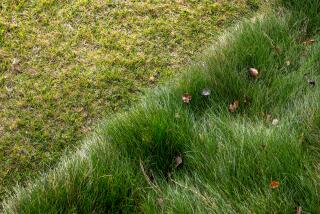GARDENING : Mulch Ado About Something : Organic, Inorganic Layers Curb Weeds, Keep Soil Moist in Summer
- Share via
When plants cry out for help in the hot, dry days of summer, give them a change of climate; give them mulch. Placing a layer of organic or inorganic material on top of your soil helps protect them from the heat and dehydration.
“Mulching modifies the climate for your plants, which is especially helpful in the heat of summer,” says John Kabashima, environmental horticulture adviser for the University of California Cooperative Extension at the South Coast Research and Extension Center in Irvine.
“Plants are like humans,” says Kabashima. “Drastic changes in temperature stress them. Mulch acts as an insulator, ensuring that the soil doesn’t heat and cool as quickly as outside temperatures.”
When we apply mulch around our plants on the soil’s surface, such as bark chips, bagged mulch mixes, peat moss and compost, we are simulating what occurs in nature. In the forest, the ground is littered with fallen vegetation that insulates the trees and other plants.
Not only does mulch prevent plants from experiencing temperature fluctuations, it also increases water penetration and keeps the soil moist, which conserves a substantial amount of water. Experts say that there is a 50% to 60% reduction in water usage when mulch is used.
Mulch also prevents erosion, and organic mulches will improve the soil. “The minerals and organic matter gradually released from decaying mulch enrich deficient soils, replacing nutrients taken up by roots as plants grow, and often enhancing earthworm populations, which have something to feed on,” says Kabashima.
As many gardeners know, lots of earthworms mean healthy soil.
Robert Browning, an English gardener in Villa Park, has been mulching his large garden for the last 35 years, and says he has lots of earthworms.
“‘I’ve been gardening this soil for a long time, and I’ve finally converted the adobe clay to soil through mulching and digging in compost,” he says.
For mulch Browning uses homemade compost or horse manure that has been composted for a few months. He routinely places mulch on his eight raised beds, where he grows a variety of vegetables throughout the year.
One use of mulch that delights most gardeners, including Browning, is to suppress weeds. The layer of mulch, if thick enough, blocks sunlight, which many seeds require to germinate, and all plants need to grow.
There are two main categories of mulches: plant-derived organic types and inorganic mulches. While both types keep soil temperatures stable, conserve water and prevent erosion, only organic mulch improves the soil.
“Before choosing a mulch, determine your purpose for using it,” says Kabashima. “If just keeping weeds under control is your desire, an inorganic mulch, like black plastic, works the best. But if you also want to improve the soil texture or properties, you need to use an organic mulch,” he says.
Also consider aesthetics when making a decision. Some mulches, such as bark chips, are much more attractive than something like shredded newspapers.
Perhaps the most important thing to consider is availability. The easier it is to get the mulch, the more likely you are to use it.
One of the most widely available sources of mulch are grass clippings and leaves, but keep a few things in mind about this type of mulch.
Although some gardeners lay their fresh grass clippings around plants, Kabashima warns against doing this until the grass has been aged.
“New, green grass clippings will actually form an impenetrable layer that the water has a difficult time getting through,” he says.
The one place experts suggest leaving fresh grass clippings is the lawn. A thin layer of clippings left on the lawn after mowing will return nitrogen to the grass.
Keep in mind that organic mulches attract decaying-vegetation lovers such as earwigs, sow bugs and snails. If not properly composted, some mulches may also contain weed seed, which may germinate.
Make sure yard-clipping mulch is weed free by composting it for a sufficient amount of time, says Paul Rogers, director of horticulture research with Kellogg Supply Inc., a Carson-based manufacturer of fertilizers and nursery supplies. “To kill off potential weed seeds, the compost must heat to 130 degrees,” he says.
If you get your mulch from packaged products, make sure that they say composted on the label.
“With some products, such as bark, there are no problems with weeds,” Rogers says.
Some gardeners are concerned that organic mulches can rob nitrogen from the soil as they decompose.
Others say it generally isn’t a problem unless the organic material is actually mixed into the soil rather than used as a mulch on the surface. Those concerned about nitrogen loss can try supplementing with a nitrogen fertilizer when mulching.
And there are conflicting opinions on whether to put mulch directly around the base of plants. The concern is that moisture at the trunk will promote crown diseases and encourage pests such as sow bugs and snails.
Some experts say you can mulch at the base of plants, if the mulch isn’t excessively moist, while others suggest playing it safe and leaving some space between the plant and mulch.
Some organic mulches contain naturally occurring toxic compounds (allelochemicals) that may damage young plants. Full composting of materials will usually solve this problem.
Mulch should be applied anywhere from one to three inches thick; on the deeper end for weed control.
“Avoid applying a really thick layer of mulch, because there won’t be enough exchange of carbon dioxide and oxygen between the ground and the air, and the plant could be smothered,” says Rogers.
It’s important to regularly replace your mulch, as organic mulches break down and are incorporated into the soil, and inorganic mulches suffer from wear and tear.






